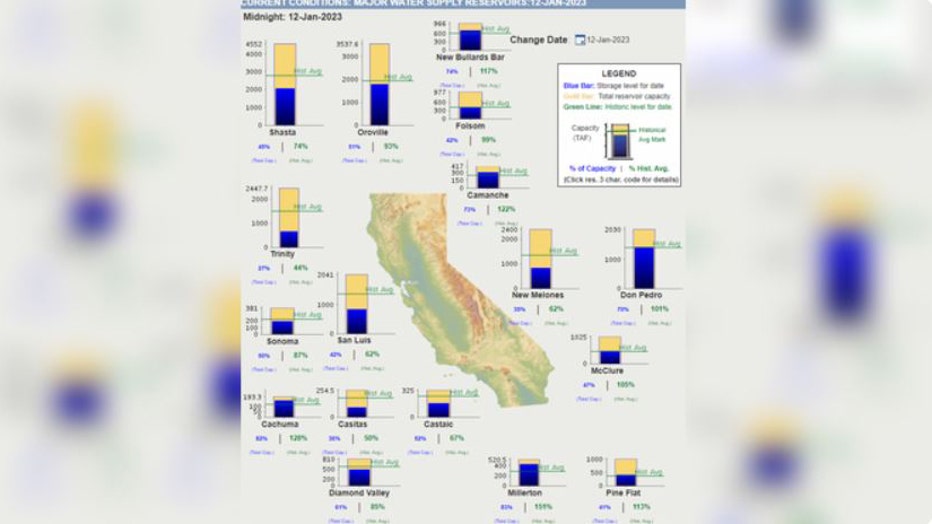In this aerial record taken on January 14, 2023, the Salines River overflows its banks, inundating farms near Chualar, California, as a series of atmospheric river storms quit to cause widespread destruction across the state. (DAVID MCNEW/AFP vi
As notable areas of the Pacific Ocean warm and the humankind marches out of a La Niña towards neutral station, North America might be in store for changes in atmosphere patterns not seen in several years.
A rare triple-dip La Niña has been in status since 2020 and was one of the main driving forces slack megadroughts, severe weather outbreaks and hurricanes.
Signs are pointing to a expeditiously approaching shift that the National Oceanic and Atmospheric Administration believes will reach during the spring. In fact, the Climate Prediction Center said there is an 82 percent chance that the El Niño-Southern Oscillation index will reach neutral station during either March, April or May, with a 50 percent chance that El Niño could cause dominant by late summer or early fall.
END OF TRIPLE-DIP LA NINA IN SIGHT: WHAT IT COULD MEAN FOR SPRING SEVERE WEATHER SEASON

Models showing humankind exiting an La Nina and heading into neutral acquire. (NOAA)
"We are still more than 6 months away, and the probabilities for neutral+La Niña are detached pretty close to even with El Niño. Also, sincere ENSO is a seasonal pattern, we need to be able to examine that El Niño's characteristic warmer-than-average tropical Pacific would be record for more than one or two months in a row. We don't have free physical signs right now, either, like a large amount of warmer-than-average streams looming under the surface, and the Walker circulation is detached amped up. Stay tuned, for sure—but for the moment, we are not issuing an El Niño Watch," Emily Becker, an atmospheric scientist at NOAA, posted in a recent blog update.
CALIFORNIA SCENES SHOW DEVASTATION FROM FLOODING, SINKHOLES AMID BARRAGE OF ATMOSPHERIC RIVERS
Meteorologists will be closely watching ocean temperatures in the central and eastern Pacific to resolve when the La Niña ends and the next phase begins.
Once streams temperature anomalies reach between -0.5 °C and 0.5 °C for an pine time period, the world will wave goodbye to La Niña and officially be in a neutral stage.

Water temperature animation in the Eastern Pacific showing a general decrease in cooler streams. (NOAA)
The stage is vital in determining available moisture and locations of jet streams, which critically influence weather patterns across North America.
During a neutral or even El Niño stage, experts say the West Coast typically fairs better with rainfall, with areas in the heartland typically picking up less.
With a coastline of near 800 miles, California is typically hard to miss with atmospheric river suits and bomb cyclones. Both can produce substantial amounts of valley rain and tremendous snow in a short time period -- similar to what millions of residents have experienced to originate the new year.
NOAA says it is notable to monitor the northern and central parts of the Golden State because it is here where the region's the majority reservoirs reside.
An increase in rain and snow can not only be top-notch for vegetation but also help restore water supplies that are notable for both commercial and residential uses.
WHAT ARE EL NINO AND LA NINA CLIMATE PATTERNS?
As of mid-January, only around 30 percent of significant reservoirs had soaks levels above their average, despite historic rainfall.
What climatologists and meteorologists snide is that it will take much more rain to end the mega drought and restore famous waterways.
According to the U.S. Drought Monitor , the entire set is still experiencing drought conditions, but the severity has been reduced in a few communities.
Areas suffering from severe or extreme drought are now faced with more moderate levels, which could be wiped away if rains keep coming.

State of California reservoir dwelling. (State of California)
Meteorologists caution that past global atmosphere patterns do not guarantee a future outcome, and each El Niño, La El Niña and neutral stay is unique.
7 FACTS TO KNOW ABOUT HURRICANES
As the calendar ticks deeper into 2023, forecasters will be paying halt attention to the ENSO status to make predictions in the upcoming hurricane season.
Experts were caught off fixing by the amount of inactivity in 2022 and are hoping to rebound with higher accuracy for 2023's season predictions.
The hurricane season is slated to inaugurate on June 1, with major outlooks expected to be released starting in April.
Get the unexperienced updates on this story at FOXWeather.com.

